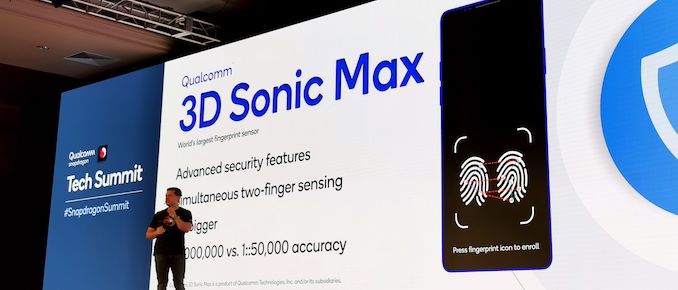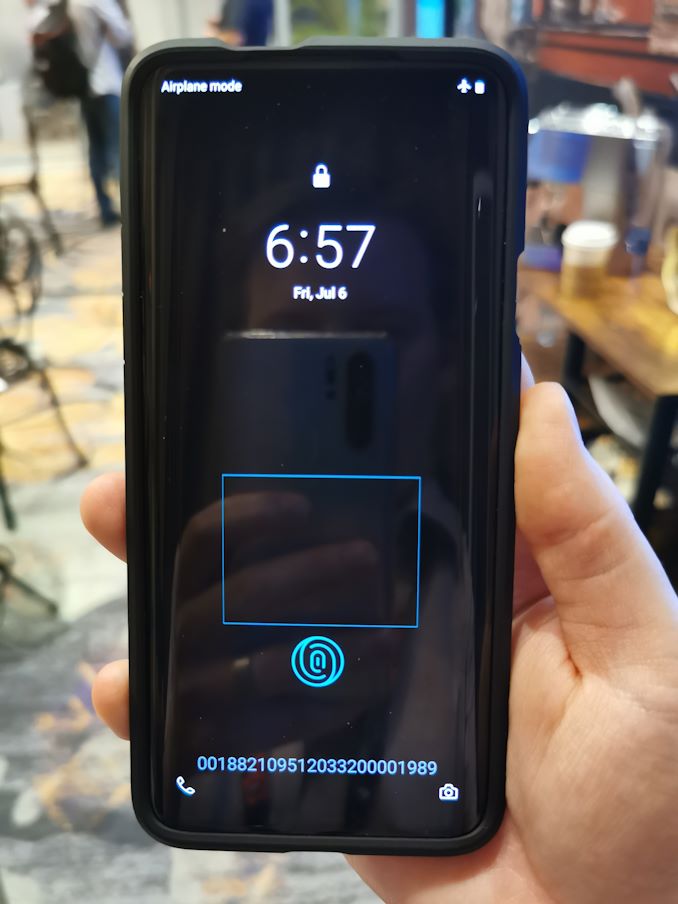This Smartphone Fingerprint Sensor Gets Two Thumbs (Up)
by Dr. Ian Cutress on December 30, 2019 12:00 PM EST
One of the cool features that came out of Qualcomm’s Tech Summit last month was its new fingerprint sensor. This one goes above and beyond anything I’ve seen before – where fingerprint sensors used to be small and have a sensing angle no bigger than a sesame seed, Qualcomm’s new 3D Sonic Max sensor is massive.
One of the key issues with modern high-end smartphones is fingerprint unlocking. Fingerprint sensors are found in one of three locations: the rear, the side (rare), or in the display. As we’ve gone through 2019, one fingerprint sensor company is promoting over 100 design wins for in-display fingerprint sensors. To be in the display, the sensor sometimes bonded to it, which causes concerns about z-height, but the main issue with in-display fingerprint sensors is the detection area.
Most in-display detection areas are quite small, often smaller than an actual thumb. And thus when a person tries to unlock the smartphone, they have to guess as to exactly where the sensor is. Given that the sensor is several millimetres wide, by being off 2-3 mm means that the likelihood of a positive unlocking is down to the quality of the sensor and the software. Some smartphones with always-on displays get around this by offering up a fingerprint area to show where you have to press, but even then that only gets displayed after you’ve touched the display once. Overall we can all agree on one thing: in-display sensors are too small.
Now it should be noted that there are two types of in-display sensor: optical and ultrasonic. Optical sensors rely on light to bounce between the fingerprint and the sensor, and this is achieved often by brightening the screen when a finger press is detected. With the right combination of hardware and software, a device might even be able to start detecting when something is about to press the sensor and anticipate it. The other type of sensor is ultrasonic, which doesn’t need light but does require direct contact. This looks at the return pattern by using ultrasonic waves through to the finger. A number of previous ultrasonic sensors have claimed superior security due to this.
So what makes Qualcomm’s new 3D Sonic Max so different? Well it’s freaking huge. It’s big enough for two fill thumbs to be used for detection at the same time.
The sensor size on the previous model was 4mm x 9mm. This time it is 20mm x 30mm, a full 16x larger than before, and as you can see from the image above, the actual detection area is slightly larger than that due to the detection methodology. The sensor can operate in single finger detection mode, or dual finger detection mode, requiring both fingers to be present when unlocking a device (make sure you don’t lose a finger). This sensor gets rid of that ‘small sensor’ problem, as a fingerprint can be detected anywhere inside that box.
Qualcomm didn’t disclose if this new sensor would cost more than their old Sonic fingerprint sensor, but it likely does. I suspect that the optical sensor companies, who control most of the market at this point, will have to make something on a similar scale in order to compete, as undoubtedly there will be one smartphone vendor brave enough to use Qualcomm’s solution in 2020, surely. Qualcomm also stated that their solution works not only in smartphones, but can also be enabled for automotive based on its security credentials. This is the point where we start our vehicles by jabbing at a large screen with our fingerprint and the system can tell who is driving.
Related Reading
- Synaptics' Next-Gen Fingerprint Sensor Security: The FS7600 Match-In-Sensor
- Synaptics at Computex: Encrypted and In-Display Fingerprint Sensors in Real Products
- Goodix Ships Optical In-Display Fingerprint Sensor for Smartphones
- Cherry Launches MC 4900 Mouse with Fingerprint Reader, 1375 DPI Sensor
- Synaptics Discusses Fingerprint Security and the Need For End-to-End Encryption
- Qualcomm Announces Snapdragon Sense ID Fingerprint Scanning











23 Comments
View All Comments
megadirk - Monday, December 30, 2019 - link
I would argue the main issue with fingerprint sensors is their inability to detect anything but a pristinling clean fingerprint.milkywayer - Tuesday, December 31, 2019 - link
Face ID made finger prints sorts obsolete. Ask anyone who has used a newer iPhone for a week or more. It's a godsend. No more fiddling with the finger print sensor. No more wiping your sweaty or wet thumb after trying and failing multiple times. Best of all, you just take the phone outta your pocket and look at the screen and it scans your face and unlocks it. After spending a year with the iPhone XS and now the Pixel 4, I'm sure face unlock will be the next flagship feature that'll trickle down to budget phones. Just a matter of time.Retycint - Tuesday, December 31, 2019 - link
Unless they've come up with a way to make an under-display Face ID, I think I'll stick with fingerprint sensors and teardrop notches/pop-up cameras. Never had a problem with the rear sensor on my Samsung S8+, and even after experiencing face ID on my mom's 11 Pro I still wouldn't take a huge notch for something that's marginally more convenient at bestshaddixboggs - Thursday, January 2, 2020 - link
Rumor is they have it on the 2020 iphones.Chaser - Wednesday, January 1, 2020 - link
I like this concept. But I am disappointed with the S10+'s unlock. I wish everyone would go secure Face ID.StevoLincolnite - Tuesday, December 31, 2019 - link
Can't say I have had much issue with my Galaxy Note 10+.I am a firefighter, so my hands are often covered in dirt, dust and soot and the unlock rate is still quick and accurate.
shabby - Monday, December 30, 2019 - link
Two thumbs will fit in a 20x30mm area? Maybe if it only detects half of each thumb.FunBunny2 - Monday, December 30, 2019 - link
or a 6 year old with indulgent parents.Ian Cutress - Monday, December 30, 2019 - link
The sensor is that big, but the detection area is wider. That box on the display has plenty of space for two thumbs.shabby - Monday, December 30, 2019 - link
Did they explain how that detection "methodology" works? I'm guessing it simply accepts partial half finger matches.